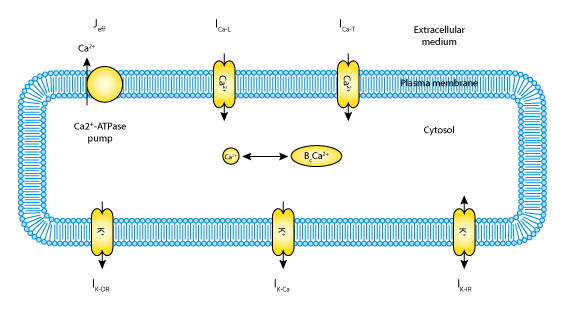Shorten, Robson, McKinnon, Wall, 2000
Model Status
This is the original unchecked version of the model imported from the previous CellML model repository, 24-Jan-2006.
Model Structure
Corticotroph releasing hormone (CRH) is one of the major regulatory hormones associated with the neuroendocrine response to stress. Pituitary corticotroph cells generate repetitive action potentials and associated Ca2+ transients in response to the agonist CRH. The mechanisms underlying this process are complex. CRH is known to activate the adenosine 3',5'-cyclic monophosphate (cAMP)-dependent protein kinase A (PKA) pathway. PKA phosphorylates L-type voltage-sensitive Ca2+ channels, activating them and contributing to the generation of an action potential and Ca2+ transients.
In an earlier Hodgkin-Huxley type mathematical model of this process, LeBeau et al. showed than an increase in the L-type current was sufficient to generate repetitive action potentials from a resting state in the model (LeBeau et al., 1997). However, they found that the action potential frequency of the model was much higher than the observed experimental action potential frequency. This problem was addressed in the current model described here (the complete original paper reference is cited below).
In addition to the activation of the L-type current, CRH also inhibits an inwardly rectifying K+ current. This current helps to maintain a negative membrane resting potential. Inhibition of this inward rectifying K+ current enhances membrane depolarisation and increases membrane excitability. By adding a component that represents the inward rectifying K+ current to the original model, the new model simulates the dual modulatory action of CRH on inward rectifier and voltage-gated Ca2+ channels better describes the experimentally observed CHR-induced effects (see the figure below).
CRH-induced Electrical Activity and Calcium Signalling in Pituitary Corticotrophs, Paul R. Shorten, A. Bruce Robson, Alan E. McKinnon and David J.N. Wall, 2000, Journal of Theoretical Biology , 206, 395-405. (A PDF version of the article is available for Journal Members on the Journal of Theoretical Biology website.)
 |
| Schematic diagram of a pituitary corticotroph cell showing the transmembrane ionic currents captured by the mathematical model. Arrows indicate ionic channels and pumps. ICa-L represents an L-type Ca2+ current responsible for most of the Ca2+ influx during an action potential. ICa-T is a T-type voltage-sensitive Ca2+ current. A voltage-sensitive K+ current, IK-DR , is mainly responsible for action potential repolarisation. A Ca2+-activated K+ current, IK-Ca , is essential for bursting behaviour. The remaining leak current, IK-IR , represents an inwardly rectifying K+ current which helps to maintain a negative resting potential. Jeff is a plasma membrane Ca2+-ATPase pump. Within the cytosol, significant portions of Ca2+ are bound to buffers. This is denoted by Bc. |
